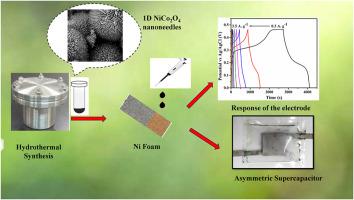1D vertically aligned NiCo2O4 nanoneedles anchored on Ni foam as a novel positive electrode for high energy density asymmetric supercapacitors
IF 4.7
3区 材料科学
Q2 MATERIALS SCIENCE, MULTIDISCIPLINARY
引用次数: 0
Abstract
One of the ongoing challenges is the fabrication of energy storage devices with high power and energy densities. This work addresses it by presenting for the first time a new hydrothermal method for synthesizing nickel cobalt oxide (NiCo2O4), and using it as an electro-active material for better power and energy densities in supercapacitors. While the XPS, BET and XRD data further validate its successful growth with large specific surface area of 46.13 m2/g, the FESEM and TEM micrographs show micro-flower like morphologies of the NiCo2O4 nanostructures comprising of large numbers of intertwined, vertically aligned 1D nanoneedles. At a current density of 0.3 A. g−1, the NiCo2O4-based electrode has a remarkable a specific capacitance of 992.3 F. g−1 along with a capacitive retention of 72 % after 5,000 cycles. An asymmetric supercapacitor (ASC) has also been constructed with the 1D vertically aligned NiCo2O4 nanoneedles anchored on Ni foam as the positive electrode, the activated porous carbon made from bio-waste as the negative electrode, PVA-KOH gel served as the electrolyte, while polyethylene terephthalate (PET) acts as the separator. The ASC fabricated with this material has been tested and returned a high energy density of 177.1 Wh. kg−1 and power density of 433.3 W. kg−1 at discharging current density of 0.33 A g−1. Consequently, our work lays the groundwork for the preparation of an electrode material based on binary metal-oxide that has a very large capacity and high energy-power densities for use in future energy storage systems.

固定在Ni泡沫上的一维垂直排列NiCo2O4纳米针作为高能量密度非对称超级电容器的新型正极
目前面临的挑战之一是制造具有高功率和能量密度的能量存储设备。这项工作通过首次提出一种新的水热方法来合成镍钴氧化物(NiCo2O4),并将其用作超级电容器中更好的功率和能量密度的电活性材料来解决这个问题。而XPS、BET和XRD数据进一步验证了NiCo2O4的成功生长,其比表面积达到46.13 m2/g, FESEM和TEM显微图显示了NiCo2O4纳米结构的微观形态,这些纳米结构由大量相互缠绕、垂直排列的1D纳米针组成。在0.3 a.g−1的电流密度下,nico2o4基电极的比电容达到992.3 f.g−1,循环5000次后电容保持率达到72%。以固定在Ni泡沫上的1D垂直排列NiCo2O4纳米针为正极,以生物废弃物制备的活性炭为负极,PVA-KOH凝胶为电解质,聚对苯二甲酸乙二醇酯(PET)为分离器,构建了不对称超级电容器(ASC)。用这种材料制造的ASC已经过测试,并返回了177.1 Wh的高能量密度。放电电流密度为0.33 A g−1时,功率密度为433.3 w kg−1。因此,我们的工作为制备基于二元金属氧化物的电极材料奠定了基础,该材料具有非常大的容量和高能量功率密度,可用于未来的储能系统。
本文章由计算机程序翻译,如有差异,请以英文原文为准。
求助全文
约1分钟内获得全文
求助全文
来源期刊

Materials Chemistry and Physics
工程技术-材料科学:综合
CiteScore
8.70
自引率
4.30%
发文量
1515
审稿时长
69 days
期刊介绍:
Materials Chemistry and Physics is devoted to short communications, full-length research papers and feature articles on interrelationships among structure, properties, processing and performance of materials. The Editors welcome manuscripts on thin films, surface and interface science, materials degradation and reliability, metallurgy, semiconductors and optoelectronic materials, fine ceramics, magnetics, superconductors, specialty polymers, nano-materials and composite materials.
 求助内容:
求助内容: 应助结果提醒方式:
应助结果提醒方式:


